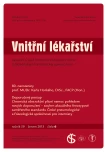The environmental estrogen bisphenol A and its effects on the human organism
Authors:
Z. Lazúrová; I. Lazúrová
Authors‘ workplace:
I. interná klinika Lekárskej fakulty UPJŠ a UN L. Pasteura Košice, Slovenská republika, prednosta prof. MU Dr. Daniel Pella, PhD.
Published in:
Vnitř Lék 2013; 59(6): 466-471
Category:
80th birthday prof. MUDr. Karla Horkého, DrSc., FACP (Hon.)
Overview
Bisphenol A (BPA), i.e. an environmental estrogen, is one of the most common synthetic chemicals which enter the human body from plastic bottles, food packaging and dental materials. As many studies show, a long‑term exposure to BPA is connected with a risk of developing various diseases and endocrine disorders. Exposure to BPA, particularly during development, increases the risk of breast carcinoma, obesity, diabetes mellitus type 2 as well as reproductive disorders. It also increases the risk of testes carcinoma and prostate carcinoma. Some isolated studies support also the relation between BPA and the risk of cardiovascular and autoimmune diseases. The effect of other xenoestrogens, such as polychlorinated biphenyls, phthalates, dioxins, as well as others, is similar or perhaps even stronger. For the time being, however, the exact pathophysiologic mechanisms of these relations are not quite clear and require further experimental, but especially human, studies.
Key words:
bisphenol A – carcinogenesis – diabetes mellitus – obesity – autoimmunity
Sources
1. Langer P. The impact of organochlorines and other persistent pollutants on thyroid and metabolic health. Front Neuroendocrinol 2010; 31: 497– 518.
2. Diamanti‑Kandarakis E, Bourguignon JP, Giudice LC et al. Endocrine‑ disrupting chemicals: An endocrine society scientific statement. Endocrine Rev 2009; 30: 293– 342.
3. Cooper JE, Kendig EL, Belcher SM. Assessment of Bisphenol A released from reusable plastic, aluminium and stainless steel water bottles. Chemosphere 2011; 85: 943– 947.
4. Erler C, Novak J. Bisphenol a exposure: human risk and health policy. J Pediatr Nurs 2010; 25: 400– 407.
5. Chunyang L, Fang L, Kurunthachalam K. Bisphenol S, a New Bisphenol Analogue, in Paper Products and Currency Bills and Its Association with Bisphenol A Residues. Environ Sci & Technol 2012; 46: 6515– 6522.
6. Raloff J. Another plastic ingredients raises safety concerns. Sci News 2010; 177: 14.
7. Verner MA, Magher T, Haddad S. High concentrations of commonly used drugs can inhibit the in vitro glucuronidation of bisphenol a and nonylphenol in rats. Xenobiotica 2009; 40: 83– 92.
8. Omoike A, Wacker T, Navidonski M. Biodegradation of Bisphenol A by Heliscus lugdunensis, a naturally occuring hyphomycete in freshwater environments. Chemosphere 2013. In press.
9. Yurino H, Ishikawa S, Sato T et al. Endocrine disruptors (environmental estrogenes) enhance autoantibody production by B1 cells. Toxicol Sci 2004; 81: 139– 147.
10. Shoenfeld Y, Agmon‑ Levin N. ASIA – autoimmune/ inflammatory syndrome induced by adjuvants. J Autoimmunity 2011; 36: 4– 8.
11. Sugiura‑ Ogasawara MOY, Ozaki Y, Sonta Set al. Exposure to bisphenol A is associated with recurrent miscarriage. Hum Reprod 2005; 20: 2325– 2329.
12. Diamanti‑Kandarakis E, Christakou C, Marinakis E. Phenotypes and environmental factors: their influence in PCOS. Curr Pharm Des 2012; 18: 270– 282.
13. Vandenberg LN, Maffini MV, Wadia PR et al.Exposure to environmentally relevant doses of the xenoestrogen bisphenol‑ A alters development of the fetal mouse mammary gland. Endocrinology 2007; 148: 116– 127.
14. Calafat AM, Ye X, Wong LY et al. Exposure of the U.S. population to bisphenol A and 4- tertiary‑ octylphenol. Environ Health Perspect 2003– 4; 116: 39– 44.
15. Carlsen E, Giwercman A, Keiding N et al. Evidence for decreasing quality of semen during past 50 years. BMJ 1992; 305: 609– 613.
16. Langer P, Kočan A, Drobna B et al. Polychlorinated biphenyls and testosterone: age and congener related correlation approach in heavily exposed males. Endocr Regul 2010; 44: 109– 114.
17. Huyghe E, Matsuda T, Thonneau P. Increasing incidence of testicular cancer worldwide: a review. J Urol 2003; 170: 5– 11.
18. Gore AC. Developmental programming and endocrine disruptor effects on reproductive neuroendocrinology. Biol Reprod 2008; 29: 358– 374.
19. Brucker‑ Davis F. Effects of environmental synthetic chemicals on thyroid function. Thyroid 1998; 8: 827– 856.
20. Langer P. Persistent organochlorinated pollutants (PCB,DDE,HCB, dioxin, furans) and the thyroid – review 2008. Endocr Regul 2008; 42: 79– 104.
21. Alonso‑ Magdalena P, Laribi O, Ropero AB et al. Low doses of bisphenol A and dietylstil-bestrol impair Ca2+ signals in pancreatic alpha‑- cells through a nonclassical membrane estrogene receptor within intact islets of Langerhans. Environ Health Perspect 2005; 113: 969– 977.
22. Lang IA, Galloway TS, Scarlett A et al. Association of urinary bisphenol A concentration with medical disorders and laboratory abnormalities in adults. JAMA 2008; 300: 1303– 1310.
23. Lee S, Kim YK, Shin TY et al. Neurotoxic effects of Bisphenol AF on calcium‑induced ROS and MAPKs. Neurotox Res 2013; 23: 249– 259.
Labels
Diabetology Endocrinology Internal medicineArticle was published in
Internal Medicine

2013 Issue 6
Most read in this issue
- Differential diagnosis and treatment of hyponatremia
- Impact of pregnancy on pituitary disorders
- Diuretics in monotherapy and in combination with other diuretics and non‑diuretics in the treatment of hypertension
- The environmental estrogen bisphenol A and its effects on the human organism
